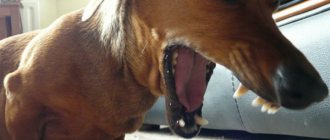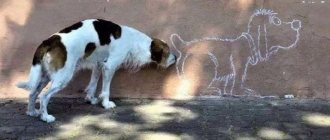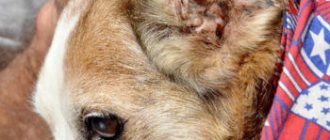The German Wirehaired Pointer, or Drathaar, was first bred in Germany at the beginning of the last century. This breed was formed as a result of crossing such hunting breeds as the Korthals Griffon, Pointer Poodle and Strechelhaar. Thanks to the unique combination of genes of worthy hunters, the Drathaar is a dog that is absolutely gentle, obedient, gets along well with children and is ideal for hunting both game and wild boar.
What to consider when building a kennel
Dog house
A dog house is a solid construction and is built to last for many years. During this time, the puppy will turn into an adult dog, so the kennel must be of the appropriate size so that the pet feels comfortable in it. It is also worth thinking about when the house will be used - all year round or during the warm season. It is important to consider where the building will be located - on the street, on a balcony or near the veranda of a country house or dacha.
Approximate dimensions of the booth
Before making a booth, it is necessary to complete a drawing of the building with clear details of all elements. The size of the pet itself should play an important role in the calculations. Dogs are very picky about their personal space, and if it is cramped inside the structure, then most likely the dog will not enter the house.
Note! If the dog sits on a chain, then there can be no talk of any stairs, balconies, turrets with sharp spiers. All these elements pose a danger to an animal tied by a collar with a chain.
The kennel should be dry and comfortable, and to maintain the premises in order, it is necessary to provide for the possibility of cleaning and disinfection. To do this, it is better to make the roof removable.
When determining the size of the booth, it is necessary to take measurements of the pet. To do this, the following animal parameters are used:
- height of the dog at the withers;
- body length from tip of nose to tip of tail;
- chest coverage;
- the height of the dog in the stance from the ground to the top of the head.
When planning to build a doghouse with your own hands, you need to take into account the following allowances when making calculations:
- The height and width of the booth frame should be equal to the height of the animal plus 5 cm.
- The depth of the building should be 5 cm greater than the length of the dog.
- The entrance is calculated so that its height is 5 cm higher than the size of the pet at the withers, and its width is the same amount wider than the half-circumference of the chest.
The size of the building for puppies and for productive bitches is determined based on the standard sizes of animals indicated in the description of the breed. If you plan to breed dogs, for young animals, before weaning from their mother, the length and width of the booth should be made 10 cm larger than the size of an adult dog. But leave the height and size of the entrance as standard. But the threshold of the manhole should be made lower to make it easier for the puppies to leave the box.
Location: street, balcony
The dog's kennel should be protected from wind and rain. This quality is especially important for structures that will be placed outdoors. In apartment buildings, dogs are often kept on the balcony. This option has a number of advantages compared to living in an isolated apartment.
A private home is more suitable for outdoor maintenance. In this case, the kennel is made taking into account the year-round keeping of the dog in it.
Balcony booth option
For an apartment balcony, the strength and reliability of the building fade into the background; here it is important to ensure safety, and this mainly concerns the equipment of the balcony itself. For a kennel, in addition to its size, you need to consider its location:
- It should not interfere with the balcony equipment.
- For safety reasons, it should be removed from the parapet so that neither the child nor the pet itself, having stood on it, could reach the balcony railing and climb over it.
Advice! If the kennel is placed on a balcony with open railings, it is recommended to make a fence of steel rod in such a way that the dog cannot stick its head outside the balcony.
Living conditions in the kennel: summer and winter conditions
To keep a dog open, many owners recommend making a house with summer and winter modes of keeping. In the summer, an additional layer of insulation is removed from a wooden house, and the booth itself is moved under a canopy or to a cooler place in the shade. For the winter period, on the contrary, insulation is done - bedding is placed inside, the walls are insulated, and the opening is equipped with a fabric screen.
On a note! For especially privileged dogs, the owners even equip a heating system by installing a film heater from the “warm floor” system or a regular electric heating pad under the floor so that the floor of the kennel does not freeze in severe frosts.
How to make a dog house with your own hands?
Before starting construction of the booth, you need to choose its location , taking into account the following requirements:
- find a dry and bright place, preferably on a hill;
- the dog must be provided with a good overview of the territory;
- the booth should be located in a place protected from the wind as much as possible, this is especially important in winter;
- provided that the dog is on a leash, within the radius of its movement there should be no trees, bushes or stumps, anything that the dog can spin around or get caught on by chain links.
When the installation location of the booth has been determined, you can begin the construction process itself. To do this, it is advisable to draw a sketch of the structure and put down dimensions. Now, according to the drawing, you can begin to install the structure.
- Construction of the booth must begin from the bottom. In order for the booth to be warm and cozy, the bottom must be made double.
- Attach four 100×100 bars vertically to the bottom of the booth, which will serve as the basis for the walls . Between them, intermediate bars will be strengthened, equal to the height of the booth, which will serve as support for the roof of the structure. In order to mark the entrance to the booth, you need to add two 40x40 mm bars.
- The inner surface of the booth must be insulated - covered with plywood or clapboard.
- The next stage is roof installation . The main thing is that the roof fits snugly against the walls of the booth, but it is advisable not to hammer it tightly. It is better to make it completely or partially removable in order to facilitate the process of cleaning and ventilating the kennel. To make the roof, you can use wooden blocks of 40x40 mm, from which a perimeter is knocked down, onto which sheets of plywood are attached.
- To insulate the ceiling, you can use glassine, polystyrene foam or mineral wool. The insulation is placed on the first sheet of plywood, and then stitched through the second. Thus, a double insulated flow was obtained.
- To protect against moisture, the roof can be covered with roofing felt, tiles or any other type of soft roof.
- Cover the outer walls of the booth with clapboard.
Materials for production
Most often, a dog house is assembled with your own hands from waste boards, timber, plywood and OSB. These are affordable materials and quite easy to work with. The main thing is to have the right tool and the desire to build a house for your pet. The most popular dog houses are booths made from pallets, wooden houses, and structures made from scrap materials.
Pallet booth
For this type of booth, wooden pallets are used as building material. The design consists of a base made of a pallet and a frame building similar to the principle of country houses. Such a structure can stand for more than one season, and if the booth is additionally insulated, the dog can be kept in it all year round.
Dog house made of pallets with a pitched roof
The size of the pallet allows you to build a structure for large dogs such as St. Bernard, German Shepherd, Husky, and Malamute. For a booth with double walls, between which the insulation will be located, you will need from 20 to 25 pallets. The material is inexpensive, and you can select the required number of whole pallets at the nearest base or construction supermarket.
Note! It is not recommended to use pallets containing fertilizers, pesticides and chemically active substances. Such containers can cause allergies in the animal. It is best to use food grade material.
Procedure:
- The pallets are carefully disassembled into planks, nails and staples are removed.
- If possible, the boards are processed - a quarter is selected to ensure a tight fit of the boards.
- The floor is made double - with the bottom row overlapping by ½ the width of the board.
- The walls are made hollow for inserting insulation.
- The roof can be made of roofing material or from pallet boards laid in a cascade. The main condition is that the boards be durable, free from rot and oil stains.
Wooden booth
For this design option, edged and unedged boards, timber, plywood and OSB are suitable. Wood is the best material for a frame and covering it with boards. You can use a wild log house design or make a house stylized as a farm. The work does not require any special skills; you can learn along the way.
The advantage of wood is that it is an environmentally friendly material. For work, you can use deciduous and coniferous wood. The frame, floor and walls can be made from boards and timber, and then sheathed on the inside with plywood or OSB. For external cladding, false timber, lining, and other types of finishing lumber are used.
Advice! You should not use birch and larch for construction. Birch wood quickly absorbs moisture and rots. Larch, on the contrary, contains a large amount of resin, and can secrete it for 20-25 years.
Booth made from scrap materials
This is the fastest and easiest option for a pet booth. Theoretically, anything that can serve as a building material and not get wet in the first rain is suitable for this purpose. Here you can use old furniture, boxes from household appliances and even bricks to build a small fortress for your dog.
OSB frame kennel
Important criteria for design:
- strength;
- safety;
- convenience for the dog.
On a note! If the booth is built from brick or stone, the inside of the building must be lined with wood or other material that will protect the animal from cold and dampness in winter.
Materials for building a booth
Most often, the kennel is made of wood . Preference should be given to coniferous species, since they are more reliable and repel insects with their smell. You can use simple edged boards. They must be planed and polished so that the animal does not get splinters. Also, the boards must be treated with antiseptic, antiparasitic, fire-resistant and moisture-resistant agents.
The outside of the kennel can be painted , but paint and varnish materials cannot be used inside, as they release substances and the dog can be poisoned. Instead of boards, cement particle boards (CPB) are sometimes used. When choosing a material, you should focus on its structure so that it does not delaminate, and on moisture resistance. Chipboard is not at all suitable for building a kennel. This material emits toxic substances and has low moisture resistance. Plywood or fiberboard are not moisture resistant , so it is better not to choose them. Foam blocks and bricks are excluded, because after a while they will begin to crumble.
The roof is covered with any kind of roofing, usually slate or roofing iron. For insulation, mineral wool, sawdust or polystyrene foam are used.
The lining inside the kennel is made of 12.5 mm thick lining .
Required Tools
To build a kennel you will need a standard home set of construction tools:
- tape measure, pencil, square, bench ruler;
- wood saw;
- hammer;
- chisel;
- screwdriver;
- drill;
- screwdriver;
- pliers
- knife;
- rasp.
Advice! It is better to take measurements of the dog using a tailor's measuring tape.
Don't forget about protective equipment. If basalt or glass wool is used to insulate a structure, you need to work with special gloves and a respirator to protect your respiratory system.
To paint, you will first need to prepare the surface. To do this, you need to clean all the nicks with sandpaper. In order for the wood to last longer, an antiseptic should be applied as the first layer, and then paint is applied.
On a note! For painting, it is recommended to use oil or acrylic paints; they are safer for the animal than alkyd and nitrophthalic enamels.
We are building an aviary
Drathaars are adapted for running over rough terrain, so it is not recommended to make the floor in the enclosure asphalt or covered with paving stones. A lawn or gravel surface is ideal for flooring.
More complete material on building an enclosure for a draathar can be found here.
The dog needs to keep his muscles in good shape and 10 square meters of enclosure area will be enough for him. As we already wrote above, one of the walls of the enclosure is made blank, and the rest are covered with chain-link. If the pet had enough shade over the enclosure, you can install a canopy.
When conceiving the design of building a dog house with your own hands, drawing up drawings and calculating the dimensions, you must immediately take into account that this is her home for years, which means it must correspond to all the characteristics of the resident, be comfortable and attractive for him. The best option for a dog house is a portable one. Over time, the space occupied by the four-legged guard may be needed for construction, planting a tree or setting up a flower bed - then you can simply move the house to another place without causing concern to the animal and without creating construction problems for the owner.
Types of dog houses
Wooden booth with a gable roof
It is quite difficult to classify buildings of this type, because in each specific case this is a separate project, the production of which is a creative matter. But here, too, one can find common features among structures in order to put them on the same level when classifying. In general, doghouses can be divided into groups:
- according to the material of manufacture - wood, plywood, OSB, brick or improvised materials;
- by type of construction - simple, consisting of one room, two or even three parts;
- by type of roof - single-pitch, gable, complex design;
- by type of equipment - insulated, simple and heated;
- in terms of external design, the structures are simple or original, made in some special style.
- depending on where the booth will be placed - on the street in the yard, in an enclosure, on the balcony, on the terrace, under the porch of the house.
We are building a booth
We start building the booth from the bottom. It is better to make the bottom of the booth double. Next, a frame is assembled above the base from a bar with a minimum cross-section of 50 by 50 mm. Then we upholster the inner wall of the booth with wooden clapboard.
We fill the space between the frame beams with ecowool or polystyrene foam. Moreover, the insulation must be wrapped in parchment or film to prevent small particles of insulation from entering the pet’s body. We cover the outer part with the same wooden clapboard.
Many dog owners make the roof of the kennel gable.
We recommend making the roof pitched so that the pet has the opportunity to remember its habits, lie on the roof and observe its territory. The roofing material should not be smooth with an angle of inclination of no more than 20 degrees. It is desirable that the roof can be opened according to the principle of opening a door for ease of ventilation and disinfection of the kennel.
You don’t have to worry about construction and buy a ready-made booth for your pet and trust the professionals!
We have been building dog houses for over 10 years and understand the needs and requirements of both owners and pets.
We can deliver the booth both in Moscow and the Moscow region, and throughout Russia.
Drawings of a doghouse with dimensions
Approximate dimensions of a dog house
Before cutting the material, you need to make a rough drawing. To do this, first carry out a general design plan, and then create a drawing with real dimensions, taking into account the size of the dog itself.
For small breeds
Small breeds of dogs, such as Pekingese or lapdogs, may well be content with a small house size:
- height – 0.6-0.7m;
- depth – 0.5-0.55m;
- width – 0.6-0.65m;
- hole size – 0.4x0.3m.
Important! For small breeds, it is recommended to make a small threshold for the opening, 2-3 cm is enough. Many animals are injured when jumping over a high threshold of 5-7 cm.
For medium breeds
For the Rottweiler, Drahthaar, and Shorthaired Pointer, the size of the structure should be chosen a little larger. These are dogs 0.6-0.7 meters high and weighing up to 30-35 kg, which means the booth must be of the appropriate size:
- height – 0.8-0.9m;
- depth – 0.7-0.75m;
- width – 0.8-0.85m;
- hole size – 0.5x0.4m.
For large breeds
But for dogs such as Doberman, Great Dane, Caucasian Shepherd, Laika, the size is selected individually, but you should focus on the following indicators:
- Height – 0.9-1.1m;
- Depth – 1.0-1.15m;
- Width – 1.35-1.55m;
- The size of the hole is 0.6-0.7x0.6 m.
Dimensions of kennels for guard breeds
Attention ! If the booth seems cramped and uncomfortable, then the dog is unlikely to live in it. If the size is too large, the dog will not be able to heat the room with its body and will freeze.
Dimensions of a doghouse for a husky . The optimal length indoors is up to 100 cm, height (excluding the roof) and width is up to 80 cm. The manhole is small in size, approximately 40-45 by 30-35 cm, with a threshold height of about 20 cm, it can be additionally upholstered with something so that it does not wear out quickly. In winter, the entrance should be covered with burlap or other dense fabric so that the door overlaps slightly over the jambs and threshold.
The size of the booth for a German shepherd : length 80 cm, width and height (at the lowest point) - 70 cm. The size of the opening is 45x35 cm. It is also advisable to provide a threshold so that water, dirt and dust remain outside.
The housing for a husky is practically no different from the place where a husky or a shepherd will live: length up to 90 cm, width and height up to 70 cm. The size of the hole is 45x35 cm.
A slightly larger booth for a Caucasian Shepherd dog . Its dimensions will be approximately the following: interior 90x80x110 cm (HxWxD). The hole is approximately 40x50 cm.
Making a booth for a balcony: step-by-step instructions
To make a booth for a balcony you will need timber, plywood, lining and insulation. The walls of the kennel will have two layers of plywood, between which you need to place insulation. It is optimal to use polystyrene foam; it retains heat well and is much easier to work with than mineral wool or natural felt.
A step-by-step algorithm for building a kennel for a medium-sized dog with a pitched roof for a balcony:
- The timber is marked - 4 pieces for the base, 4 racks for the walls, 4 bars for the roof.
- The base is assembled from the bars, then the bottom and floor of the booth are cut out.
- First, the bottom is nailed, then the insulation is installed, after which the floor is nailed.
- Vertical posts and bars for the roof are installed.
- Next is the installation of the inner lining of the booth.
- After this, the insulation is attached.
- External cladding is being installed.
- A manhole template is cut out of cardboard and an outline is drawn on the facade. A hole is cut out with a jigsaw.
- 2 roof parts are cut out, bars are attached and insulation is installed.
Note! When installing insulation inside the kennel, you cannot cover it with polyethylene or linoleum - this will not improve hygiene, but such covering may simply cause the dog to get cold. It is better to cover it with felt or tarpaulin made from natural fabrics.
Booth dimensions
The size of the booth depends on the size of the animal. The kennel should not be too large, because in winter it is difficult to warm it up and the dog will freeze . In a small booth the animal will be cramped and uncomfortable. The dog should freely enter the kennel, turn around in it and lie stretched out.
To build a kennel you need to know the following dimensions of the dog:
- Height at withers.
- Distance from the withers to the tip of the front paws.
- Width at chest.
- Length from nose to tail.
The height of the booth (H) should allow the dog to sit quietly inside and not touch the ceiling with its head. Therefore, the height is calculated as follows: the height of the dog at the withers plus 10-15 cm. The second parameter is important for determining the depth of the kennel (L): the dog must be placed inside so that it can lie freely on its side, with its paws stretched forward. To this distance you need to add another 10-15 cm. Usually the booth consists of two parts: a vestibule and a berth. The vestibule performs an important function:
- the dog does not immediately get from the street to its sleeping place, that is, the dirt remains mainly in the vestibule;
- hides from the sun in the vestibule
- In winter, the vestibule protects the sleeping place from the cold.
Based on this, the width of the booth (W) consists of the width of the vestibule and the berth. The width of the vestibule can be made to any size, the main thing is that it is comfortable for the dog to enter and exit it. But the width of the sleeping place should be 10-15 cm greater than the length of the dog from nose to tail.
The entrance to the kennel (hole) is of great importance It should not be too large so that in winter it does not let out heat or let in cold, or too small so that it is inconvenient for the dog to get in or out. The height of the hole (h) is made 5-10 cm less than the height of the dog at the withers. The width of the hole (w) is 5-10 cm greater than the width of the dog in the chest.
If the roof is pitched, then the front wall should be higher than the back wall, since water should drain behind the booth.
After determining the dimensions of the kennel, you need to draw a sketch to determine the design and a drawing for the convenience of building the kennel. It should be borne in mind that the hole is usually made on a long wall closer to the corner. This also applies to the internal entrance if there is a vestibule. This placement allows you to leave more usable space.
Making a pet booth outdoors
Insulating the booth with polystyrene foam
The instructions for making a booth for outdoor maintenance are similar to building a kennel for a balcony. The difference is that here you will have to additionally work on the waterproofing and base of the booth. Procedure:
- The base of the booth is made from blocks of wood.
- Bars are nailed to the bottom side, which will serve as the legs of the booth; their lower part is upholstered with metal or rubber.
- The frame of the booth is knocked down.
- The inner surface is covered with plywood or OSB.
- Insulation is being installed.
- External cladding is being done.
- To give a beautiful look, additional decorative cladding is done with clapboard or false beams.
- The roof frame is mounted, insulation is installed and the roofing material is covered.
For the summer period, a wooden floor in the booth is enough, but for the winter you can use an old blanket. If heating is planned in the booth, then the floor is covered with metal, on top of which a layer of plywood or other material is laid. In this case, it is recommended to lay a mat made of felt or textile covering.
On a note! You can give your booth a modern, attractive look with the help of multi-colored paints, decorative overlays and other elements.
Construction of a booth
- The floor should not touch the ground, so the booth must be placed on brick legs or an elevated foundation must be made. The floor is made double and insulated. The frame for the floor of the booth is made from bars with a cross-section of 10*10 cm. Holes are pre-drilled in the bars for self-tapping screws that connect the structure at the corners. Additional 4*4 cm boards are nailed across the frame to secure the floor so that it does not sag under the weight of the dog. The floorboards are then nailed tightly to the frame. The floor must be free of cracks. This can lead to injury to the dog and heat loss.
- At the corners of this structure, 4 bars with a cross section of 10*10 cm are nailed vertically. At the site of the future manhole, two bars of 4*4 cm are nailed. The same bars are nailed between the corner beams for additional roof support and wall strength. All these vertical posts must be connected at the top by beams located parallel to the bottom.
- The outside of the structure is covered with boards .
- The structure is treated with protective agents . Then it is turned upside down, onto which roofing felt is attached for waterproofing. Then two fastening bars with a cross-section of 10*5 cm are nailed. They also need to be treated with protective agents. Next, the floor is insulated (the structure is turned upside down to its normal position). glassine is attached to the bottom with a stapler , insulation is laid on top and glassine again, it is necessary so that the insulation does not get inside the booth. At this stage the finished floor can be laid.
- The walls are insulated in the same way as the floor. After laying the insulation, the walls inside are sheathed with clapboard.
- The roof can be flat or gable. In any case, the roof must be removable . This will make it more convenient to clean the kennel or provide emergency medical care to your pet. For a flat roof, 4*4 cm bars are used. They are used to make a frame , on top of which the lining is strengthened. Insulation is similar to walls and floors. The second layer of lining is laid on top and the roof is installed. For a gable roof, triangular elements are made - these are two bars connected at an angle of 40 degrees. These elements are nailed to the longitudinal slats of the booth wall and secured on top with a ridge. Next, follow the same steps as when constructing a flat roof.
- The opening is reinforced with a frame and can be covered with a curtain. In winter, it will not let warm air out of the booth, and in summer it will allow hot air inside.
- The last step is to paint the outer wall of the kennel with varnish. There should be at least two layers of varnish.
As you can see, it is not that difficult to build a doghouse for your dog. The main thing is to take the correct measurements, draw a drawing according to which the kennel will be assembled and do not forget about special impregnations and products that will help extend the life of the dog’s personal house. It is necessary to use only natural materials , since synthetic ones emit chemicals and can confuse the dog’s sense of smell.
A little about insulation
In order for even a small dog to feel comfortable in a kennel in winter, the issue of insulating the building should be approached correctly. The floor in a booth for outdoor use must be insulated with polystyrene foam no less than 5 cm thick. Extruded polystyrene can be installed on the inside; it is stronger than usual and, thanks to its porous surface, retains heat well. For the same purpose, you should install a curtain on the manhole.
Additional Information. When using electric heating, you should not install a homemade control unit, much less connect a voltage of 220 volts to the heating element. The connection diagram must have a thermostat and a circuit breaker.
Having studied the features of assembling a doghouse, you can get to work, because there is nothing difficult in building such a structure, even for beginners in construction.
Contents of the drathaar
Drahthaar dogs are distinguished by their unpretentiousness and ease of maintenance. They need to be washed as needed, and their short coat, up to 3 centimeters long, does not require special care. Keeping these dogs in urban environments does not present any particular problems. It is enough to arrange long walks together in the park, swims on the lake or morning jogs.
When walking the Drahthaar, you don’t have to worry about conflicts with stray dogs or cats, since German Wirehaired Pointers have a very calm and balanced character. For his comfortable stay in a city apartment, you need to choose a place that is located away from the heating system and the corridor.
Train your drathaar puppy to his bed or rug in advance, and you will always be able to find him in his place. Dogs of this breed feel much better in the fresh country air. The versatility of the drathaar allows its skills to be used not only for hunting, but also for protecting a personal plot. Build a booth with an enclosure for him and you won’t have to worry about the safety of your property.
Something along the way
In conclusion, we will give some information on a related topic - about keeping a dog in a kennel. The first question is bedding. What to stuff the mat and pillow with? It is undesirable to use hay and straw, as has been done since ancient times; parasites will infest it, and the human nose can smell such a dwelling from afar. The dog will soon tear the foam rubber with its claws and eat its crumbs, which will not do it any good. Special mats are expensive.
It is best to make a dog bed from tarpaulin and stuff it with cedar sawdust; they are sold specifically for this purpose. They will also be used for hygienic filling of the floor. You can use other pine sawdust, but be sure to dry it well, for 2 weeks at temperatures above 22 degrees. You need to dry it by spreading it in a thin layer. And a simple coniferous backfill will have to be replaced in a week or two, while cedar backfill lasts for a month or more.
The second question is more serious - ticks. A properly built and equipped kennel will not allow parasites to breed inside, especially if the dog wears an anti-flea collar. But, alas, there is no reliable preventative against ticks; these creatures are too resilient.
Just pulling out an embedded tick, as you probably know, is dangerous to your health. Veterinarian services cost money, and the nearest veterinary care point may be miles away. However, you can remove the tick yourself with a special tool – a tick twister. Therefore, in conclusion, instead of edifications and instructions, we suggest simply watching a video on how to make a tick twister and how to use it:











